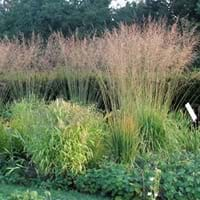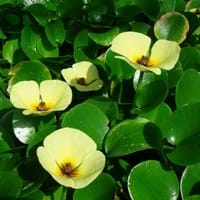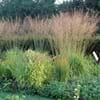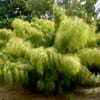Life Span
Perennial
Perennial
Origin
Europe, Eastern Europe, Southern Europe, Russia/Siberia, Asia, Central Asia, Southern Asia
South America
Types
Not Available
Not available
Habitat
Boggy areas, Dry and Young forest Heaths, Lowland
Lakes, Ponds
USDA Hardiness Zone
5-8
9-11
Sunset Zone
1a, 1b, 2a, 2b, 3a, 3b, 4, 5, 6, 7, 8, 9, 14, 15, 16, 17
21,22
Habit
Arching/Fountain-shaped
Spreading
Flower Color
Dark Purple
Yellow, Light Yellow, Brown
Flower Color Modifier
Bicolor
Bicolor
Fruit Color
Non Fruiting Plant
Non Fruiting Plant
Leaf Color in Spring
Green
Green
Leaf Color in Summer
Light Green
Green
Leaf Color in Fall
Green, Gold
Green
Leaf Color in Winter
Tan
Green
Leaf Shape
Needle like
Heart-shaped
Plant Season
Spring, Summer, Fall, Winter
Spring, Summer, Fall
Sunlight
Partial Sun, Partial shade
Full Sun, Partial Sun
Type of Soil
Clay, Loam, Sand
Loam, Sand
The pH of Soil
Acidic, Neutral
Neutral
Soil Drainage
Average
Poorly Drained
Bloom Time
Early Summer, Summer, Late Summer, Early Fall
Indeterminate
Tolerances
Not Available
Shade areas, Wet Site
Where to Plant?
Ground, Pot
In Water
How to Plant?
Divison, Transplanting, Vegetative Reproduction
By dividing rhizomes, tubers, Corms or bulbs, Offsets
Plant Maintenance
Low
Low
Watering Requirements
Requires regular watering, Water more frequently during periods of extreme drought
Medium
In Summer
Lots of watering
Lots of watering
In Spring
Moderate
Moderate
In Winter
Average Water
Average Water
Soil pH
Acidic, Neutral
Neutral
Soil Type
Clay, Loam, Sand
Loam, Sand
Soil Drainage Capacity
Average
Poorly Drained
Sun Exposure
Partial Sun, Partial shade
Full Sun, Partial Sun
Pruning
Prune in winter, Remove damaged leaves, Remove dead branches, Remove dead leaves
Remove damaged leaves, Remove dead branches, Remove dead flowers, Remove dead leaves
Fertilizers
No need to fertilize every year
All-Purpose Liquid Fertilizer
Pests and Diseases
Pests and diseases free
No serious insect or disease problems
Plant Tolerance
Not Available
Shade areas, Wet Site
Flower Petal Number
Single
Single
Foliage Texture
Medium
Medium
Foliage Sheen
Matte
Glossy
Attracts
Not Available
Birds, Insects
Allergy
Not Available
Not Available
Aesthetic Uses
Showy Purposes, Water gardening
Water gardening
Beauty Benefits
Not Available
Not Available
Environmental Uses
No fertilizer, pesticides, or herbicides needed
Air purification
Medicinal Uses
No Medicinal Use
Not Available
Part of Plant Used
Whole plant
Flowers
Other Uses
Used as Ornamental plant
Used as Ornamental plant
Used As Indoor Plant
No
No
Used As Outdoor Plant
Yes
Yes
Garden Design
Bedding Plant, Container, Cutflower, Dried Flower/Everlasting, Mixed Border
Container, Water Gardens
Botanical Name
Molinia arundinacea
HYDROCLEYS nymphoides
Common Name
Moor Grass
Water Poppy
In Hindi
Tall Moor Grass
जल पोस्ता
In German
Hoch Pfeifengras
Wasser Poppy
In French
Herbe Moor hauteur
eau Poppy
In Spanish
Tall Grass Moor
amapola agua
In Greek
Ψηλός Moor Grass
νερό παπαρούνας
In Portuguese
Alto Moor Relva
água Poppy
In Polish
Wysoki Moor Trawa
Woda Poppy
In Latin
Alta Maurus Grass
Aqua Poppy
Phylum
Magnoliophyta
Magnoliophyta
Class
Liliopsida
Liliopsida
Order
Cyperales
Alismatales
Family
Poaceae
Alismataceae
Clade
Angiosperms, Commelinids, Monocots
Angiosperms, Monocots
Tribe
Not Available
Not Available
Subfamily
Not Available
Not Available
Number of Species
Not Available
Difference Between Molinia Arundinacea and Water Poppy
If you are confused whether Molinia Arundinacea or Water Poppy are same, here are some features about those plants to help you choose better. Many people think that these two plants have the same characteristics, but one can see Molinia Arundinacea and Water Poppy Information and learn more about it. Fertilizers required for proper growth of Molinia Arundinacea are No need to fertilize every year, whereas for Water Poppy fertilizers required are All-Purpose Liquid Fertilizer. Hence, one should know the basic difference between Molinia Arundinacea and Water Poppy if you are planning to have them in your garden to enhance its beauty.
<
Flowering PlantsImportance of Molinia Arundinacea and Water Poppy
Want to have the most appropriate plant for your garden? You might want to know the importance of Molinia Arundinacea and Water Poppy. Basically, these two plants vary in many aspects. Compare Molinia Arundinacea and Water Poppy as they differ in many characteristics such as their life, care, benefits, facts, etc. Every gardener must at least have the slightest clue about the plants he wants to plant in his garden. Compare their benefits, which differ in many ways like facts and uses. The medicinal use of Molinia Arundinacea is No Medicinal Use whereas of Water Poppy is Not Available. Molinia Arundinacea has beauty benefits as follows: Not Available while Water Poppy has beauty benefits as follows: Not Available.
Compare Facts of Molinia Arundinacea vs Water Poppy
How to choose the best garden plant for your garden depending upon its facts? Here garden plant comparison will help you to solve this query. Compare the facts of Molinia Arundinacea vs Water Poppy and know which one to choose. As garden plants have benefits and other uses, allergy is also a major drawback of plants for some people. Allergic reactions of Molinia Arundinacea are Not Available whereas of Water Poppy have Not Available respectively. Having a fruit bearing plant in your garden can be a plus point of your garden. Molinia Arundinacea has showy fruits and Water Poppy has no showy fruits. Also Molinia Arundinacea is not flowering and Water Poppy is not flowering . You can compare Molinia Arundinacea and Water Poppy facts and facts of other plants too.





